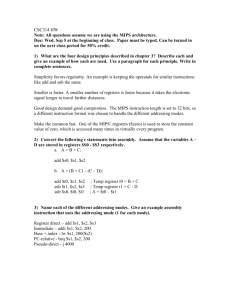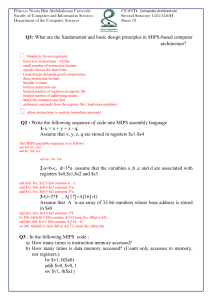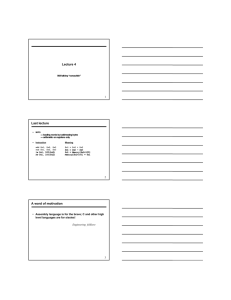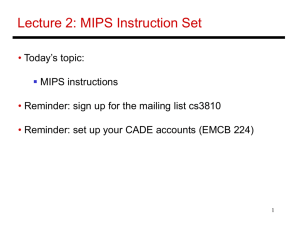Instruction Set
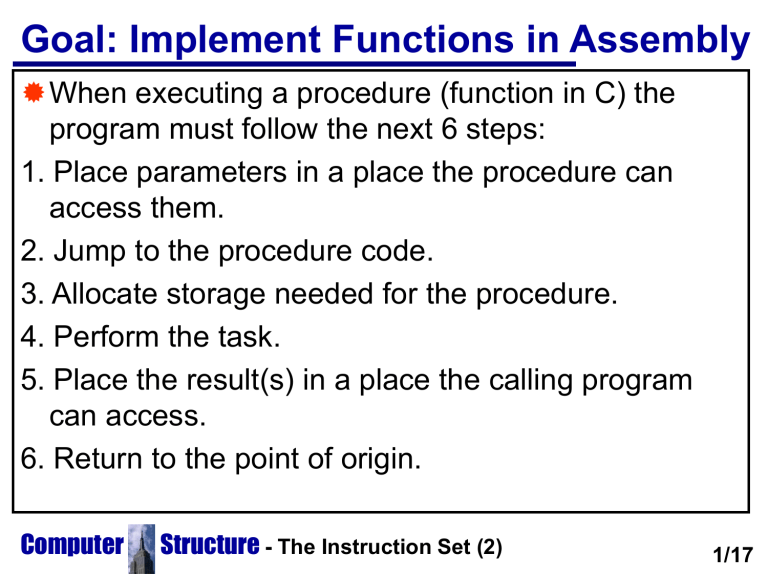
Goal: Implement Functions in Assembly
When executing a procedure (function in C) the program must follow the next 6 steps:
1. Place parameters in a place the procedure can access them.
2. Jump to the procedure code.
3. Allocate storage needed for the procedure.
4. Perform the task.
5. Place the result(s) in a place the calling program can access.
6. Return to the point of origin.
Computer Structure
- The Instruction Set (2)
1/17
Registers for Procedures
MIPS software allocates the following of its
32 registers for procedure calling:
$a0 - $a3 : 4 argument registers
$v0 - $v1 : 2 return value registers
$ra : return address register to return to point of origin.
2 new instructions that support procedures are:
jal ProcedureAddress
Jump and link, jump to the procedure and save the address of the following instruction in $ra .
jr register
Jump register, jump to the address in the register .
Computer Structure
- The Instruction Set (2)
2/17
Using More Registers
If the compiler needs more than the 4 input and 2 output registers, it can use other registers.
But it must restore the values in those registers to the values before the procedure was called.
This is a case of register spill , register values are saved in memory.
The ideal structure for saving registers is the stack , values are pushed onto the stack before the procedure call and poped out after.
A register called the stack pointer ($sp ) points to the address in memory where the stack resides.
Computer Structure
- The Instruction Set (2)
3/17
Compiling a Leaf Procedure
int leaf(int g,int h,int i,int j){ int f;// the arguments are in $a0-$a3, f=(g+h) - (i+j); //f is in $s0 return f;
}
Before continuing we will introduce a new instruction: addi $t0,$t0,10# $t0=$t0+10 add immediate (addi) has as one of its operands an immediate value. addi is of the I-type instructions and in fact gives the format its name.
Computer Structure
- The Instruction Set (2)
4/17
The Assembly Version
subi $sp,$sp,12#make room for 3 items on stack sw $t1,8($sp) #save $t1 sw $t0,4($sp) #save $t0 sw $s0,0($sp) #save $s0 add $t0,$a0,$a1 # $t0=g+h add $t1,$a2,$a3 # $t1=i+j sub $s0,$t0,$t1 # f=$t0+$t1 add $v0,$s0,$zero # $v0=$s0 lw $s0,0($sp) #restore $s0 lw $t0,4($sp) #restore $t0 lw $t1,8($sp) #restore $t1 addi $sp,$sp,12#remove the room on the stack
- The Instruction Set (2)
Picture of Stack
High address
$sp $sp
$sp
Contents of register $t1
Contents of register $t0
Contents of register $s0
Low address a.
b.
c.
MIPS software offers 2 classes of registers:
$t0-$t9 : 10 temporary registers, not saved by the procedure.
$s0-$s7 : 8 saved registers, saved by the procedure.
Computer Structure
- The Instruction Set (2)
6/17
Nested Procedures
leaf procedures, procedures that call others are called nested procedures.
Problems may arise now, for example the main program calls procedure A with the argument 3 in
$a0 and the return address in $ra . Procedure A then calls procedure B with the argument 7 in $a0 and with its return address in $ra . The previous address saved in $ra is destroyed.
We must, somehow, preserve these values across calls.
Lets look at a translation of the recursive factorial function in C++.
Computer Structure
- The Instruction Set (2)
Factorial in C++
int fact(int n)
{ if(n < 1) return (1); else return (n * fact(n -1));
}
The function calls itself multiple times.
The argument n is in register $a0 , which is saved on the stack along with $ra .
Computer Structure
- The Instruction Set (2)
7/17
Factorial in Assembly
fact: subi $sp,$sp,8 # make room for 2 items sw $ra,4($sp)# push the return address sw $a0,0($sp)# push the argument n slt $t0,$a0,1 # test for n<1 beq $t0,$zero,L1 # if n>=1 goto L1 li $v0,1 # pseudoinstruction $v0=1 addi $sp,$sp,8 # pop 2 items off stack jr $ra
The following is the recursive call to fact(n-1)
L1: subi $a0,$a0,1 # n-jal fact # call fact(n-1) lw $a0,0($sp) # return from fact(n-1) lw $ra,4($sp) # pop n and return address addi $sp,$sp,8 # pop 2 items off stack mult $v0,$a0,$v0 # return n * fact(n-1)
- The Instruction Set (2)
Procedure Frame
is preserved ( רמשנ ) by making sure that the callee ( תארקנ היצקנופ ) doesn't write above $sp .
$sp is preserved by adding exactly the amount subtracted from it.
All other registers are preserved by being saved on the stack.
The stack also contains local variables that don't fit into registers.
The segment of the stack containing the saved registers and local variables is called the procedure frame or activation record.
Computer Structure
- The Instruction Set (2)
Frame Pointer
Some MIPS software use the register $fp to point to the first word of the procedure frame or activation record .
High address
$fp
$fp
$sp $sp
$fp
Saved argument registers (if any)
Saved return address
Saved saved registers (if any)
Local arrays and structures (if any)
Computer Structure a.
$sp c.
9/17
Static and Automatic Variables
C++ has two storage classes for variables automatic and static .
Automatic variables are local to a function and are deleted when the function exits.
Static variables exist across function calls. Global
C++ variables are static, as well as any variables defined with the keyword static. All other variables are automatic.
MIPS software reserves a register called the global pointer or $gp. Static variables are accessed through this register.
Computer Structure
- The Instruction Set (2)
10/17
Immediate Operands
constant called an immediate . Using I-type instructions avoids loading values from memory into a register. Examples of instructions which use immediate values are: multi $s0,$s1,4 # $s0=$s1*4 slti $t0,$s2,10 # $t0=1 if $s2<10
But if a constant is larger than 16 bits? MIPS provides an instruction lui that loads a 16 bit constant into the upper half of an register.
In order to load the value:
0000 0000 0011 1101 0000 1001 0000 0000 into $s0 we must perform: lui $s0,61 #61d = 0000 0000 0011 1101 addi $s0,$s0,2304 # 2304d = 0000100100000000
Computer Structure
- The Instruction Set (2)
Addressing in Branches and Jumps
j 10000 # go to location 10000
Jumps to the address 10000 in memory.
2 10000
6 bits (opcode) 26 bits (address)
bne $s0,$s1,Exit # branch if $s0!=$s1
5 16 17 Exit
6 bits 5 bits 5 bits 16 bits (address)
Problem : Addresses have to fit into a 16-bit field, no program could be larger than 64KByte.
Solution : Specify a register which would be added to the branch address. But which register?
Computer Structure
- The Instruction Set (2)
11/17
PC-Relative Addressing
The Program Counter (PC) is a register that always contains the address of the current instruction being executed.
By using the PC as the register to add to the branch address we can always branch within a range of
-2 15 to 2 15 -1 bytes of the current instruction.
This is enough for most loops and if statements.
This is called PC-relative addressing .
Procedures are not usually within a short range of the current instruction and thus jal is a J-type instruction.
Computer Structure
- The Instruction Set (2)
12/17
Branch Offset in Machine Language
Lets look at a loop in assembly:
Loop: .
.
bne $t0,$t1,Exit subi $t0,$t0,1 j Loop
Exit:
The machine code of the bne instruction is:
5 8 9 8
The branch instruction adds 8 bytes to the PC and not 12 because the PC is automatically incremented by 4 when an instruction is executed.
In fact the branch offset is 2 not 8. All MIPS instructions are 4 bytes long thus the offset is in words not bytes. The range of a branch has been multiplied by 4.
Computer Structure
- The Instruction Set (2)
13/17
Branch Offset Example
48
52 subi $t0,$t1,1035 bne $zero,$t0,L1
. . .
76 L1: jr $ra
What is the machine code translation of bne ?
opcode : 5, the opcode of bne.
rs : 0, $zero is register #0.
rt : 9, $t0 is register #9.
address : (L1 - PC)/4 = (76 - 56)/4 = 20/4 = 5
And if L1 is at address 28?
address : (L1 - PC)/4 = (28 - 56)/4 = -28/4 = -7
Computer Structure
- The Instruction Set (2)
14/17
Pseudodirect Addressing
The 26-bit field in the jump instruction is also a word address. Thus it is a 28-bit address. But the PC holds 32-bits?
The MIPS jump instruction replaces only the lower
28 bits of the PC, leaving the 4 highest bits of the
PC unchanged.
48
. . .
j L2
334500 L2: add …
What is the machine code translation of j ?
opcode : 2, the opcode of j.
address : PC
32-29
|| 83625
Computer Structure
- The Instruction Set (2)
15/17
Addressing Mode Summary
Immediate addressing - the Operand is a constant
Register addressing - the Operand is a register
Base or displacement addressing - the operand is at the memory location whose address is the sum of a register and a constant in the instruction.
PC-relative addressing - the address is the sum of the PC and a constant in the instruction.
Pseudodirect addressing - the jump address is the
26 bits of the instruction concatenated ( ףרוצמ ) to the upper bits of the PC.
Computer Structure
- The Instruction Set (2)
16/17
Immediate addressing - the Operand is a constant addi $t0,$t1, 102 # $t0=$t1 + 10 andi $s0,$s0, 16 # $s0=$s0 & 16
Register addressing - the Operand is a register addi $t0,$t1 ,102 andi $s0,$s0 ,16 jr $s4 # jump to the address in $s4
Base or displacement addressing - the operand is at the memory location whose address is the sum of a register and a constant in the instruction.
lw $t0, 20($gp) # $t0 = $gp[5] lb $t1, 7($s5) # $t0 = $s5[7]
PC-relative addressing - the address is the sum of the PC and a constant in the instruction.
beg $s0,$s1, Label # if $s0<$s1 jump to Label
Pseudodirect addressing - the jump address is the 26 bits of the instruction concatenated ( ףרוצמ ) to the upper bits of the PC.
j L37 jal strcmp
Addressing Modes (picture)
1. Immediate addressing op rs r t Immediate
2. Register addressing op rs r t rd . . .
funct
3. Base addressing op rs r t
Register
Address
+
Registers
Register
Memor y
Byte Halfword Word
4. PC-relative addressing op rs r t
PC
Address
Memor y
Word +
5. Pseudodirect addressing op Address
PC
Computer Structure
- The Instruction Set (2)
Memor y
Word
17/17
